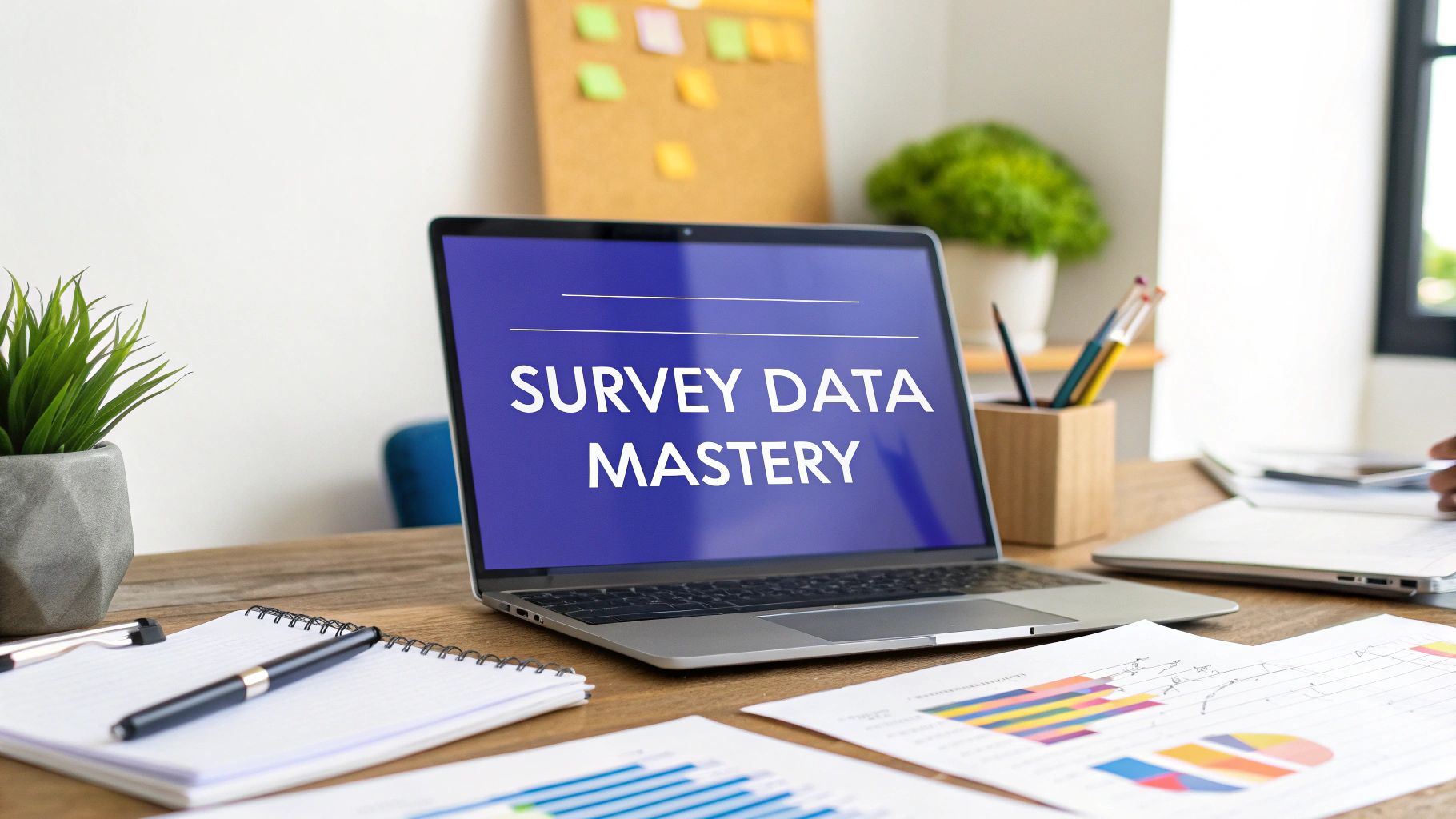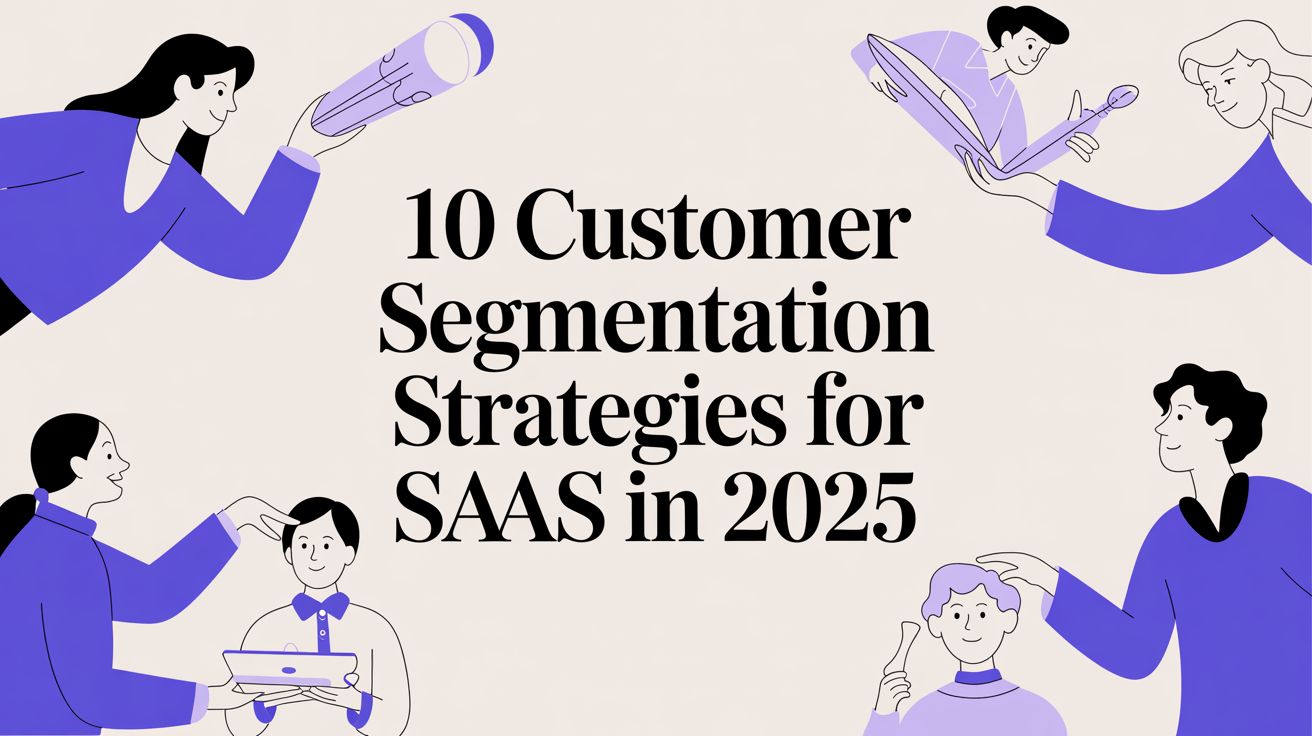Mastering Survey Data Analysis From Start to Finish
Turn raw survey results into actionable business intelligence. This guide to survey data analysis covers techniques, tools, and best practices.

So, what is survey data analysis, really?
At its core, it’s the art of turning raw, messy feedback into clear, actionable insights. It’s how you figure out what your customers truly think and need, swapping guesswork for smart, informed decisions. For any SaaS company, this is the secret sauce for everything from tweaking product features to gauging customer mood and crafting marketing that actually lands.
Turning Raw Feedback Into Business Intelligence
Picture this: you have just received hundreds of responses from your latest customer satisfaction survey. You’re staring at a mountain of ratings, multiple-choice answers, and a lot of open-ended comments. On its own, this pile of raw information is just noise. It can be overwhelming.
Survey data analysis is the structured approach you use to bring order to that chaos. It's about organizing, interpreting, and ultimately finding the story hidden within that noise. This method is less about just counting things and more about translating customer voices into a language your team can use and act on.
The end goal here is to make better choices. It’s about being able to master data-driven decision making for your business. When you do it right, you’ll start to see patterns, connections, and opportunities that were completely invisible before.
The Foundation Of Strategic Growth
Think of effective analysis as the engine that drives your strategy. Instead of assuming you know what users want, you can lean on hard data to guide every move. This is a game-changer in the competitive SaaS world, where keeping customers happy and constantly improving your product are directly tied to your bottom line.
- Refine Product Features: Pinpoint which features your best customers can't live without and which ones are just causing headaches.
- Gauge Customer Sentiment: Keep a pulse on customer happiness, tracking how it shifts over time or after a big update.
- Shape Effective Marketing: Hear the exact words your customers use to describe their problems, letting you create messaging that truly connects.
This shift to data isn't just a hunch; the market backs it up. The global market for research services hit an estimated $84 billion in 2023 and is still climbing. A huge part of that growth is fueled by digital tools, with the online survey software market expected to reach nearly $5 billion by 2026. These numbers paint a clear picture: businesses are betting big on data to sharpen their thinking.
A Four-Stage Process
The journey from a messy spreadsheet to a clear, compelling report can be broken down into a few core stages. This is not a one-step "analyze" button; it's a process.
This diagram gives a great high-level view, starting with design and moving through to cleaning and analysis.

What this really shows is that powerful insights are built on a solid foundation. You can't jump straight to the sexy charts and graphs without first doing the important work of designing a good survey and cleaning up the data.
To make it even clearer, let’s break the workflow down into four distinct stages.
Most analysis projects, big or small, follow this general path. These four stages help you organize your workflow and make sure you don't miss any key steps on the way to finding those game-changing insights.
The Four Core Stages of Survey Data Analysis
StageObjectiveKey Activities1. Data PreparationClean and structure the raw dataset to achieve accuracy and consistency.Removing duplicates, handling incomplete responses, correcting errors, and coding open-ended answers.2. Descriptive AnalysisSummarize the basic features of the data to get a high-level overview.Calculating percentages, means, medians, modes, and frequencies for key questions.3. Inferential AnalysisLook for relationships and differences between respondent groups to find deeper trends.Using techniques like cross-tabulation to compare segments (e.g., new vs. loyal users).4. Reporting & ActionCommunicate the key findings in a clear, compelling way to inform business strategy.Creating charts, writing summaries, and presenting actionable recommendations to stakeholders.
From getting your data ready for prime time to presenting your final report, each stage builds on the last. Nail these, and you'll be well on your way to turning customer feedback into your company's most valuable asset.
Preparing Your Raw Data for Accurate Analysis
Before you can dig into your survey responses to find those game-changing insights, you have to get the raw data in shape. This step, often called data cleaning or data scrubbing, is the most important, and frequently the most time-consuming, part of the whole process.
Skipping it is like trying to cook a gourmet meal with unwashed vegetables straight from the garden. No matter how good your cooking skills are, the final dish is going to be a letdown.
Think of your raw data as that fresh harvest. It’s full of potential, but it’s also covered in dirt (errors), has a few weeds mixed in (irrelevant responses), and some of it might just be unusable (incomplete data). Data prep is the process of meticulously washing, peeling, and chopping those ingredients so they’re ready for the main event: analysis.
Getting this right sets the foundation for everything that follows. After all, flawed data leads to flawed conclusions, which can trigger some seriously poor business decisions.
The First Step: Data Cleaning and Validation
The first job is to clean up your dataset by finding and either fixing or tossing out inaccuracies. This is not about deleting a few bad rows; it's a systematic check for quality and consistency across all your responses.
Poor data quality can creep in before you even collect a single answer, which is why it's so important to learn how to write survey questions that are crystal clear.
Here are some common cleaning tasks you'll run into:
- Removing Duplicate Entries: It happens. A user might accidentally submit a survey twice. You’ll need to remove these to avoid giving one person's opinion double the weight.
- Handling Incomplete Responses: What do you do with a survey that’s only half-finished? You need a consistent rule. Either remove these partials entirely or decide if there's still enough useful information to keep them.
- Addressing Outliers: Outliers are those responses that are wildly different from everything else. For instance, if most users rate a feature between a 3 and a 5 (on a 5-point scale) and one person rates it -100, that’s a bizarre outlier. It's almost certainly an error and should be fixed or removed.
This screenshot lays out a pretty standard data cleaning checklist, highlighting the key areas to focus on.

As you can see, it breaks down preparation into concrete actions like removing irrelevant respondents and fixing structural errors. Both are fundamental for trustworthy analysis.
Structuring and Coding Your Dataset
Once the data is squeaky clean, the next step is to structure it for analysis. This is a huge deal, especially for those open-ended, qualitative questions where people type out their own answers.
Raw text is tough to analyze statistically, so you need to convert it into a structured format. This process is called coding.
Coding is all about reading through those open-ended comments and grouping similar responses into categories or themes. For example, if you see comments like "The app is too slow," "It takes forever to load," and "I wish it were faster," you could code all of them under a single theme: "Performance Issues."
Key Insight: The goal of coding isn't to change what people said. It's about organizing that unstructured text into categories you can actually count. This lets you see how many people mentioned "performance," "user interface," or "pricing," effectively turning qualitative feedback into hard numbers.
Properly structuring your data also means organizing your dataset logically. Typically, each row represents one respondent, and each column represents a specific question. This standard format is exactly what most analysis tools, from a simple spreadsheet to advanced software like SPSS, are built to handle, making your move into the analysis phase a whole lot smoother.
Choosing the Right Analysis Method for Your Data
Alright, you’ve collected and cleaned up your survey data. So, what’s next? Now comes the fun part: picking the right way to analyze it all to dig up those game-changing insights. Not all data is created equal, and the techniques you use should be a direct match for your survey questions and what you’re trying to figure out for your business.
Think of yourself as a detective standing over a pile of clues. You have different tools for different jobs, a magnifying glass for tiny fibers, fingerprint dust for prints, and chemical kits for unknown substances. You wouldn’t dust for prints on a liquid stain, right? The tool has to match the evidence. It's the exact same idea here. The analysis method you choose has to fit the kind of data you've gathered.
Your survey data will almost always fall into two main buckets: quantitative and qualitative. Figuring out this difference is the first step to picking the right tool for the job.
Quantitative vs. Qualitative Data
The core difference between these two types of data really just boils down to what they represent.
- Quantitative Data is anything you can count or put a number on. This is your multiple-choice answers, your yes/no questions, and those "rate your satisfaction from 1 to 5" scales. This data tells you the "what," "how many," and "how often."
- Qualitative Data is the descriptive, non-numerical stuff. It’s the raw text you get from open-ended questions like, "How can we improve?" or "Describe your experience." This data gives you the "why" behind the numbers, including the rich context, personal opinions, and stories.
Key Insight: One isn't better than the other; they just do different jobs. Quantitative data gives you the hard numbers and statistical proof, while qualitative data adds the human detail that brings those numbers to life. A truly powerful survey data analysis uses both.
Methods for Analyzing Quantitative Data
When you’re dealing with numbers, a few trusty statistical techniques can help you make sense of it all and spot meaningful patterns.
- Descriptive Statistics: This is your starting point, the absolute foundation of your analysis. It’s all about summarizing your data to get a quick, high-level picture. You’ll look at the mean (the average score), the median (the middle value in a range), and the mode (the most popular answer). For instance, finding out your average customer satisfaction score is a 4.2 out of 5 is a simple but powerful descriptive insight.
- Crosstabulation (Cross-Tabs): This technique is fantastic for finding hidden relationships in your data. It lets you compare two different questions to see how they connect. For a SaaS company, you could run a cross-tab to see if feature requests from your free users are different from your paid users. Or you could check if customer satisfaction scores change depending on how long someone has been a customer.
- Regression Analysis: This one is a bit more advanced, but it’s incredibly powerful. Regression helps you figure out how different factors (like pricing, specific features, or support quality) influence a key outcome, like customer loyalty. It helps you answer questions like, "Which of these things has the biggest impact on our churn rate?"
Methods for Analyzing Qualitative Data
Analyzing a wall of text from open-ended questions can feel a bit messy, but with the right approach, you can turn those opinions into organized, actionable insights. There's a lot to unpack here, and you can get more specific methods in our complete guide to data analysis in a survey.
For now, here are two of the most common ways to tackle qualitative feedback:
- Thematic Analysis: This is where you roll up your sleeves, read through the comments, and start grouping them by recurring ideas or themes. You might create buckets like "Pricing Concerns," "Positive Onboarding Feedback," or "Bug Reports." Suddenly, that intimidating wall of text becomes a neat, quantifiable list of your users' biggest talking points.
- Sentiment Analysis: This method uses technology, often AI, to automatically scan text and classify the underlying emotion as positive, negative, or neutral. For any busy SaaS team, this is a lifesaver. You can get an instant pulse on customer mood across thousands of comments without having to read every single one. Surva.ai has this built right in, helping you spot sentiment shifts the moment they happen.
So, how do you choose? It all comes down to what you want to learn. The table below breaks it down simply, helping you match the right technique to your goal.
Quantitative vs. Qualitative Analysis Techniques
To help you decide, here’s a quick look at how these techniques stack up and what they’re best used for.
TechniqueBest ForExample ApplicationDescriptive StatisticsSummarizing the overall trends in your data.Finding the average satisfaction score for a new feature.CrosstabulationComparing how different user segments answered.Seeing if users on the "Pro Plan" request different features than users on the "Basic Plan."Regression AnalysisPredicting how one metric affects another.Determining if faster support response times lead to higher Net Promoter Scores (NPS).Thematic AnalysisIdentifying common topics in open-ended feedback.Discovering that 35% of churned users mentioned "missing integrations" in their exit survey.Sentiment AnalysisGauging the emotional tone of written comments at scale.Tracking whether customer sentiment becomes more positive after a major product update.
Ultimately, picking the right method isn’t about finding the most complicated or impressive-sounding technique. It’s about choosing the one that will give you the clearest answer to your most important business questions.
Leveraging Tools for Efficient Survey Analysis

Trying to manually analyze survey data can feel like you're trying to build a complex piece of furniture with nothing but a pocket knife. Sure, you might get there eventually, but the process will be slow, frustrating, and probably full of little mistakes. Thankfully, modern software makes this whole process faster, more accurate, and a whole lot less painful.
The right tools do more than just speed up your workflow; they unlock deeper insights that you’d almost certainly miss doing it by hand. They transform survey data analysis from a tedious chore into a genuine strategic activity. The key is picking the right tool for the job, which really depends on how complex your data is and what your team needs to accomplish.
From Simple Spreadsheets to Specialized Software
When it comes to analysis tools, your options generally fall into three buckets. Each one serves a different purpose, from quick summaries to deep statistical dives.
- Spreadsheets (Excel, Google Sheets): These are the versatile multi-tools in data analysis. They’re perfect for basic tasks like cleaning up data, running descriptive stats, and creating simple charts or pivot tables. For smaller surveys with straightforward quantitative data, a spreadsheet is often all you need for a clear overview.
- Statistical Software (SPSS, R): When you need to get more advanced and run statistical tests like regression or factor analysis, you'll need to turn to a dedicated statistical package. These tools are built for academic-level rigor and can handle huge, complex datasets. While incredibly powerful, they usually have a steep learning curve and are often overkill for a SaaS team’s typical feedback analysis.
- All-in-One Survey Platforms (Surva.ai): This is where most modern SaaS teams strike gold. Integrated platforms like Surva.ai bring data collection, analysis, and reporting together into one seamless workflow. They automate many of the most mind-numbing steps, putting powerful analysis features right into the hands of product managers, marketers, and customer success teams, with no data scientist required.
The Power of Integrated Platforms
The real magic of an all-in-one platform is just how automated and accessible it makes everything. Instead of exporting data from one tool just to import it into another, the entire survey data analysis process happens under one roof. This saves a ton of time and dramatically cuts down the risk of human error.
Surva.ai, for example, was built specifically for this. It automates key parts of the process, from flagging incomplete responses as they come in to generating visual reports on the fly. This integration means your team can get immediate insights as the data rolls in, not weeks after the survey has closed.
Key Takeaway: The goal of using a tool isn't just to crunch numbers faster. It's to close the gap between collecting feedback and taking action on it. An integrated platform makes that loop nearly instantaneous.
Here are a few features that make this happen:
- Real-Time Dashboards: You can see results as they happen with charts and graphs that update automatically. This lets you monitor trends and spot issues without having to wait for a final report.
- AI-Powered Sentiment Analysis: Let’s be honest, manually reading through thousands of open-ended comments is just not practical. AI can instantly sort feedback into positive, negative, or neutral buckets, giving you a high-level view of customer mood in seconds. For diving deeper into qualitative analysis and pulling insights from open-ended responses, customizable AI assistants like Custom ChatGPT can really boost your efficiency.
- Automated Cross-Tabulation: Easily segment your data to see how different user groups are responding. With just a few clicks, you can compare feedback from brand-new users to that of your power users, uncovering priceless insights for personalization.
By building these capabilities directly into the survey tool, platforms like Surva.ai make data analysis a team sport. They give everyone on your team the power to explore feedback, find answers, and make informed decisions without needing a Ph.D. in statistics. This is how you turn customer feedback into a continuous engine for growth.
Common Pitfalls in Data Analysis and How to Avoid Them
Even with the best tools and a clear goal, it’s surprisingly easy to make mistakes that can sink your survey data analysis. Getting from raw numbers to clear, actionable insight means you have to be vigilant. There are a few common traps that can completely distort your results and lead you to the wrong conclusions.
Think of it like being a pilot. You might have the most advanced plane in the world, but if you misread your instruments or ignore warning signs, you still risk flying way off course. Knowing these potential errors is the first step to making sure your analysis lands you exactly where you need to be: with accurate, trustworthy insights.
Avoiding Sampling and Question Bias
One of the most common and damaging errors is sampling bias. This is what happens when the group of people who actually respond to your survey doesn’t look like the larger audience you’re trying to understand. The result? A skewed perspective that can lead you completely astray.
For example, imagine you only send a survey to your most active, long-term customers. Their feedback will probably be glowing and focused on advanced features. While that’s great to hear, it completely ignores the experience of new users or those who are struggling, giving you a dangerously incomplete picture of your product's health.
To avoid this, use a random sampling method whenever you can. It gives everyone in your target population an equal shot at being selected. If you need to focus on specific segments, be intentional about it and make sure you also gather feedback from other groups to get a balanced view. A better response rate can also help fight bias; you can find solid strategies to improve survey response rates to get a more representative sample.
Similarly, question bias pops up when the way you word your questions nudges people toward a specific answer. Leading questions, confusing jargon, or double-barreled questions (asking two things at once) can all push respondents in a certain direction or just plain confuse them.
- Leading Question: "How much do you love our amazing new feature?"
- Better Question: "How would you rate your experience with our new feature on a scale of 1 to 5?"
A/B testing different question phrasings with a small group before a full launch is a fantastic way to spot and fix potential bias before it can do any real damage.
Overcoming Confirmation Bias and Technical Oversights
Another subtle but powerful pitfall is confirmation bias. This is that all-too-human tendency to seek out and favor information that confirms what we already believe. When you're analyzing data, this might mean you unconsciously focus on the positive comments while brushing off the negative feedback.
Key Takeaway: To counteract confirmation bias, you have to actively seek out disconfirming evidence. Make it a rule to ask yourself, "What data would prove my current belief wrong?" and then actually go look for it. This forces you to engage with the entire dataset, not just the parts that make you feel good.
A more technical issue, but just as important, is forgetting to design for all devices. The survey experience can be drastically different on a desktop versus a mobile phone, and ignoring this can corrupt your data. A survey that looks perfect on a big screen might be a nightmare on a phone, with tiny text, buttons that are impossible to tap, or broken formatting. This just leads to frustrated users who either give up or rush through without thinking.
And the shift to mobile is no small thing. By Q3 2024, over 61% of survey responses worldwide were submitted on mobile devices, a huge jump from 52% in late 2020. This data makes it clear that a mobile-first approach is not just a nice-to-have anymore; it's a necessity for collecting accurate data. You can explore more about these market research trends to get the full picture.
Ultimately, strong survey analysis is just as much about avoiding mistakes as it is about using the right techniques. By staying aware of these common pitfalls, from biased samples to your own personal blind spots, you can protect the quality of your insights and make decisions with real confidence.
Frequently Asked Questions About Survey Analysis

Even after a close look into survey data analysis, a few questions always seem to pop up. We get it. Let’s tackle some of the most common ones we hear from teams just getting their feet wet.
What Is the Difference Between Correlation and Causation?
This is a big one, and getting it wrong can completely derail your analysis. Think of it this way: correlation simply means two things seem to happen in tandem. For instance, you might notice that customers who use a specific feature also happen to report higher satisfaction.
Causation, on the other hand, is a much higher bar. It means one thing directly causes another. Proving causation is tough and usually requires controlled experiments like A/B testing, not just survey data alone. A classic mistake is seeing a correlation and assuming it's causation, which can lead you to make bad business decisions based on a faulty link.
How Large Does My Sample Size Need to Be?
The "perfect" sample size really depends on how big your total audience is, how much room for error you're okay with, and how confident you want to be in your findings.
For most business scenarios, a 5% margin of error with a 95% confidence level is a solid gold standard. This means you can be 95% sure your results are within +/- 5% of what your entire user base actually thinks.
There are plenty of free online calculators to help you find your magic number. And while a bigger sample is generally better, you'll hit a point of diminishing returns. You don't need to survey every single user to get reliable insights.
Key Insight: A small, representative sample is way more valuable than a huge, biased one. Your focus should always be on getting quality responses from a group that truly reflects your overall customer base.
How Do I Analyze Open-Ended Questions Effectively?
Digging into qualitative text responses is all about spotting patterns and themes in what people are saying. You can do this the old-school way by manually reading through the feedback and grouping similar comments into categories, a process known as coding.
A much faster and more scalable approach, however, is using software with Natural Language Processing (NLP). Tools with this tech can automatically run sentiment analysis to classify comments as positive or negative. They can also use topic modeling to pull out the key themes, saving you a ton of time and removing a lot of human bias from the equation.
Ready to stop wrestling with spreadsheets and turn that messy feedback into clear, actionable insights? Surva.ai is an AI-powered platform that automates your survey data analysis, helping you find customer sentiment, identify key themes, and make smarter decisions faster. Stop guessing and start knowing. Explore Surva.ai today.


